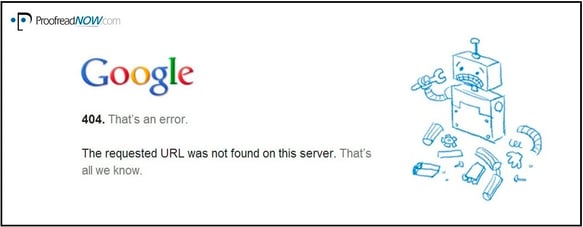These days, businesses can flourish or fail based on websites alone.
Your website encapsulates your world. If a potential customer wants to understand who you are and what you offer, he or she will likely visit your website to find out.
For that reason, glaring errors on your website are not peripheral issues—they are right hooks to the body of your brand. If the first impression you give is “weclome” on your home screen, you’re not exactly proving how precise and trustworthy your work is.
In particular, make sure to proofread these four areas of your website.
(Note: To learn about four specific grammar mishaps that will tarnish your brand, click here.)
1) The Copy
The part of your website that is most important to protect is the copy itself. Strong personality, bright colors, and sophisticated syntax will not save sloppy content.
According to Branding Beat, you have approximately six seconds to capture the attention of your website visitors. Imagine if their six-second experience of your brand includes a spelling or grammar error. You’ll have left an indelible impression—but not for the better.
We’ve seen so many companies misspell words in the headline image of a blog post or the first paragraph of page copy. These are places on your site that are meant to attract your visitors’ attention and draw in skeptics. The consequences of a glaring error are multiplied when the error is found in those prominent pieces of copy.
Give special attention to these other areas on your website as well:
- Home page
- Landing pages
- Writer bios
- Taglines
2) Links

Because we proofread websites, we’ve picked up on the worst trends in company websites.
Here’s what we’ve learned: bad links are everywhere. Two issues you need to be sure of:
- Make sure all of your links actually work.
- Make sure every link goes where it’s supposed to go.
I have a very recent example of a company botching number two. In my inbox today was an email with a great offer, but when I clicked on the link it sent me to the wrong page of the website. The content on the page was irrelevant to me and the offer I was interested in was nowhere to be found.
Three or four hours later I got an apology email from the company. What an embarrasment to be the marketing person responsible for sending that email. If I were intent on buying that product or service, I would have bought it from somebody else.
In general, make sure every link on your site is logical and delivers on what it promises. If you’ve got a dropdown menu that says “Pricing,” it should lead to pricing information. If you’ve got a link that says “I want more information,” it should direct a visitor to more information or at least to an information request form.
3) Special Offers/New Editions
You know the value of a good marketing offer.
A temporarily free e-book or a discounted service can provide a great spike in your website traffic and brand exposure. The problem is that many of these last-minute add-ons to your site are hastily put together and are often error-prone.

Sometimes, you’ll only have an offer up on your site for a day. It may not seem important to proofread that offer since it won’t be there long. However, one wrong character can be devastating.
For example, if you’re offering a discounted price on a product or service, one number is the difference between $10 and $100, or even $30 and $40. If you misrepresent your offer, even by mistake, your brand will take a hit.
4) Emails
While email content doesn’t necessarily correlate with your website, the two often work as one.
Typically, your cold emails or newsletters are sent with the purpose of driving traffic to your website. In that case, the content in your email is judged as critically as your website itself—maybe even more so.
All the usual proofreading warnings apply: check for proper grammar and spelling and make sure links work and direct to the desired page. However, email has a few unique problems to watch out for. For example, make sure that when your email says you’ve attached something, you’ve actually done it.
In the wise words of one blogger, sending an email without proofreading is like shooting a gun without aiming.
Conclusion
You’ve worked too hard establishing your brand image to have it ruined by a few misplaced keystrokes. Take the time to pore over your website to polish it. Or, if you don’t have the time, you could always use a professional service such as ours.
********
Trying to figure out if outsourcing your proofreading is the best way to go? We’ve put together a guide for you.



